The Importance and Traits of Purple Crystals
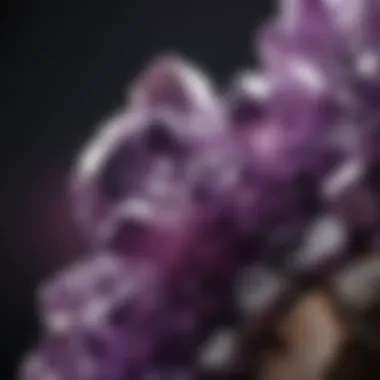

Intro
Purple crystals captivate collectors and enthusiasts alike due to their unique beauty and diverse uses. These minerals, formed over millions of years, hold geological secrets and cultural significance. A deep dive into their origins reveals fascinating stories about their formation and the roles they've played in human history. This article aims to provide thorough insights into purple crystals, equipping readers with knowledge about their geological characteristics, prominent varieties, and their application in various contexts.
History and Origins
Overview of Collectibles, Rocks, and Fossils
The allure of purple crystals goes beyond aesthetics. Many collectors seek them for their unique formations and vibrational properties. Collectible purple stones like amethyst, charoite, and fluorite not only serve as decorative pieces but carry potential metaphysical benefits as well. The wide variety in shape, size, and clarity makes them appealing to both novice and seasoned collectors.
Historical Significance and Cultural Impact
Historically, purple crystals have held significant value across various cultures. For example, amethyst has been prized since antiquity. Ancient Greeks believed it could ward off intoxication and was often used in royal regalia due to its association with nobility. In many cultures, purple stones symbolize stability, mental clarity, and spiritual protection.
Purple crystals also appear in various religions. In Christianity, amethyst is one of the twelve stones in the Breastplate of Aaron, symbolizing spiritual insight. In modern times, these crystals continue to be embraced for their purported healing properties in holistic practices, further demonstrating their lasting impact.
Identification and Classification
Guide to Identifying Rocks and Fossils
Identifying purple crystals requires an understanding of their physical properties. Key characteristics include color intensity, clarity, and specific hardness measured by the Mohs scale. Amethyst typically ranges from light lilac to deep violet. Its clarity can vary dramatically, affecting both its value and appeal to collectors.
Common Types and Variations
- Amethyst: The most recognized purple crystal, known for its vibrant hues.
- Fluorite: Often presenting in a mix of colors, its purple variants show clarity and unique patterns.
- Charoite: Characterized by swirling patterns of violet and lavender tones.
Understanding these varieties enhances collector knowledge and aids in making informed purchases.
"Purple crystals serve as a reminder of the stunning beauty found within the Earth and its historical treasures."
In summary, purple crystals are not just aesthetically appealing; they embody significant geological history and cultural narratives. By delving deeper into their origins and characteristics, collectors and enthusiasts can appreciate the complex stories that these stunning minerals tell.
Preamble to Purple Crystals
Purple crystals hold a distinctive place in the realm of gemstones and minerals, attracting attention through both their rarity and vibrant hues. The significance of these crystals goes beyond their aesthetic appeal. They embody various characteristics that reflect significant geological processes and cultural beliefs.
Understanding purple crystals is essential for enthusiasts and collectors. It allows individuals to appreciate their formation and identify their unique properties. Knowledge about these crystals can also enhance one’s collecting experience, guiding decisions on both acquisition and preservation.
Overview of Crystallography
Crystallography is the scientific study of crystals and their structures. This field addresses the arrangement of atoms within a crystal and how this structure influences the crystal's properties. For purple crystals, crystallography reveals essential details regarding their formation and classification. Each type of purple crystal exhibits a specific lattice structure and symmetry. For instance, amethyst, a variant of quartz, typically forms hexagonal prisms, while fluorite may present in isometric forms.
The investigation into crystallography highlights more than just appearances. It offers insight into how environmental factors contribute to the development of these crystals. Factors such as temperature, pressure, and chemical composition play crucial roles in determining the final characteristics of a crystal.
Defining Characteristics
The defining characteristics of purple crystals include color, hardness, and the presence of inclusions. Their striking shades of violet can arise from various elements. For example, iron impurities often give amethyst its purple coloration, while the deep purple of fluorite may come from different trace elements.
- Color Variety: Purple crystals range from light lavender to deep violet, presenting colors influenced by their composition.
- Hardness: On the Mohs scale, most purple crystals have a moderate hardness, making them suitable for various applications.
- Inclusions: Some crystals feature unique inclusions or patterns, adding to their allure and distinguishing one specimen from another.
Each of these elements plays an important role in the classification and valuation of purple crystals within the market. Collectors value specimens not only for their beauty but also for the knowledge embedded in their unique characteristics.
Common Types of Purple Crystals
Understanding the common types of purple crystals is crucial for both collectors and enthusiasts. Each variety possesses distinct characteristics that contribute to its unique appeal and usage. From their geological formation to cultural significance, these crystals play a vital role in various fields, including jewelry making and holistic practices. Furthermore, knowing these crystals can enhance your appreciation of their beauty and importance.
Amethyst: The Most Renowned
Amethyst stands out as the most widely recognized purple crystal. Its vibrant hue ranges from deep violet to lighter lavender shades. This quartz variant is highly sought after in both the jewelry industry and for collection purposes. The geological origins of amethyst lie in volcanic rocks, where the perfect conditions allow the crystal to grow and develop its rich color.
The crystal is well-known for its metaphysical properties. Many believe it possesses calming and protective qualities which can alleviate stress and promote clarity. Beyond its mystical appeal, amethyst is also valued for its physical attributes. It demonstrates a hardness of 7 on the Mohs scale, making it relatively durable for various applications.
"Amethyst is not only a beautiful stone but also a powerful ally in personal well-being and clarity of thought."
Collectors often seek high-quality amethyst to enhance their displays. Notable sources of amethyst include Brazil and Uruguay, known for producing large and high-grade specimens. Knowing where to source authentic amethyst is essential to avoid fakes.
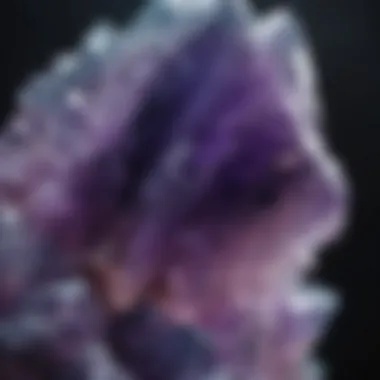
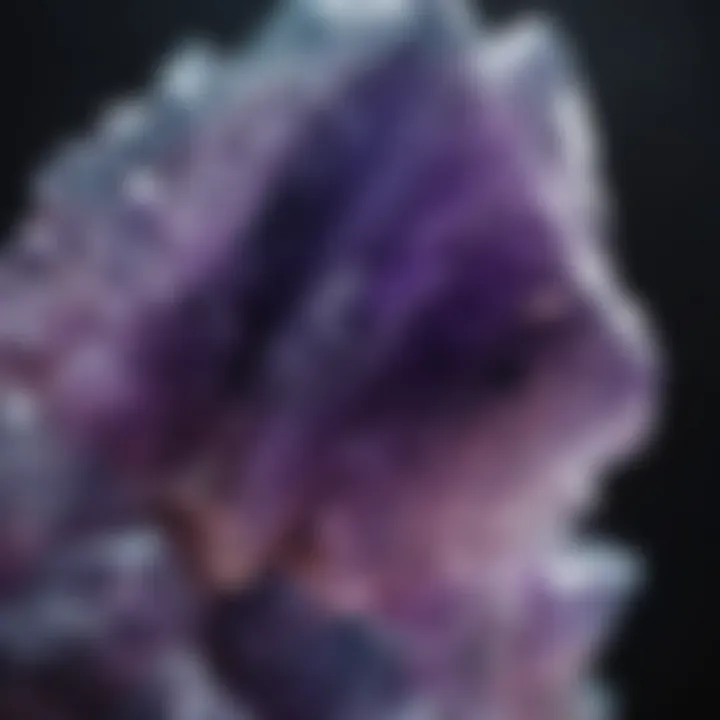
Fluorite: A Versatile Mineral
Fluorite, another noteworthy purple crystal, is recognized for its striking colors and transparency. Often exhibiting a purple hue among various other colors, fluorite is appreciated for its wide array of applications. This mineral crystallizes in cubic formations and is sought after for both its aesthetic qualities and its utility in industry.
The crystalline structure of fluorite gives it a unique characteristic called fluorescence, making it glow under ultraviolet light. This property has made it popular among collectors and mineralogists. Its hardness is around 4 on the Mohs scale, meaning it is more fragile than amethyst but still holds value in various settings.
Fluorite finds its usage in multiple domains, including metallurgy and glassmaking, due to its ability to lower melting points. Its prospect as a healing stone is also of interest to many, believed to aid in mental clarity and decision-making.
Sugilite: A Rare Gem
Sugilite represents the rarest of the purple crystals discussed here. It is characterized by its deep purple color, often interspersed with black or pinkish veining. Discovered in Japan in 1944, this mineral is a member of the cyclosilicate group. Its rarity and distinctive color set it apart from other gemstones, captivating collectors around the world.
Sugilite is thought to hold strong metaphysical properties, often associated with spiritual growth and emotional healing. Many gem enthusiasts are drawn to it not only for its beauty but also for its perceived ability to aid in personal transformation and emotional well-being.
In terms of hardness, sugilite rates a 5.5 to 6.0 on the Mohs scale. Collecting sugilite should be approached with caution, as imitations exist. Understanding the context of its origin—mainly in South Africa—is key when assessing its authenticity and value.
By delving deeper into these remarkable crystals, collectors and enthusiasts gain a richer understanding of their significance, both in terms of beauty and their broader implications in culture and well-being.
Geological Formation of Purple Crystals
The geological formation of purple crystals is a critical aspect of understanding their significance and properties. These processes and conditions shape each crystal's unique characteristics. Examining how purple crystals form can provide insight into their value and applications. It also reveals the intricate connections between geology, mineralogy, and the broader environment.
Formation Processes
Purple crystals primarily form through natural geological processes that can take thousands to millions of years. The main formation processes include crystallization, metamorphism, and volcanic activity.
- Crystallization: This occurs when minerals dissolve in liquid solutions and gradually solidify. As the environment changes, factors such as temperature and pressure influence the outcome. Many purple crystals, like amethyst, develop in this fashion within geodes.
- Metamorphism: Some purple crystals arise when pre-existing rocks undergo metamorphic heat and pressure. These conditions can lead to the formation of complex minerals with various colors, including shades of purple. For example, fluorite can form under these conditions.
- Volcanic Activity: Certain purple crystals form in volcanic environments where lava cools rapidly. This creates unique structures and properties. The high temperatures during eruptions, followed by rapid cooling and solidification, contribute to the crystallization process.
Each of these processes demonstrates the remarkable flexibility and adaptability of minerals, showing how unique environmental conditions result in diverse crystal formations.
Environmental Conditions
The environmental conditions that promote the formation of purple crystals are integral to understanding their properties. Several factors play a significant role in this context:
- Temperature: The temperature range where minerals crystallize varies widely. For many purple crystals, moderate to high temperatures are ideal for growth. These conditions may occur naturally underground or near volcanic activity.
- Pressure: Similar to temperature, pressure can significantly affect crystal growth. Higher pressure conditions often lead to more complex structures, enabling larger crystals to develop.
- Chemical Composition: The presence of specific elements influences the color and properties of the crystals. For example, iron and manganese ions contribute to the distinctive purple hue in amethyst.
- Liquid Solutions: The saturation level of minerals in water or other solutions is vital for crystallization. This saturation allows minerals to precipitate when conditions change, leading to the formation of solid crystals over time.
Crystal formation is less about random chance and more about precise environmental conditions. Understanding these processes provides deep insights into mineral properties and their eventual uses.
Properties of Purple Crystals
Understanding the properties of purple crystals is essential for both collectors and enthusiasts. These elements are not merely academic; they provide the foundation for identifying, valuing, and appreciating these unique minerals. Purple crystals display distinct physical qualities that differentiate them from other types. They also possess notable chemical compositions, which can affect their uses and how they should be treated. Its importance lies in both practical applications and broader cultural aspects associated with the stones.
Physical Properties
Physical properties of purple crystals encompass a variety of attributes, including hardness, luster, cleavage, and specific gravity. For example, the hardness of amethyst, a prominent purple crystal, ranks 7 on the Mohs scale, making it quite durable and suitable for jewelry. Its glassy luster adds to its appeal. On the other hand, fluorite is softer, ranking between 4 and 5 on the Mohs scale. This variance impacts how these minerals are used in both decorative items and jewelry.
In terms of cleavage, some purple crystals exhibit perfect cleavage, which influences how they break or fracture under stress. This is important when evaluating their authenticity since pieces with poor cleavage might suggest man-made products or alterations. Additionally, specific gravity helps in assessing their density. Understanding these physical characteristics is imperative for collectors, as they provide insights into the durability and potential applications of purple crystals.
Chemical Composition
The chemical composition of purple crystals varies significantly among different types, contributing to their unique properties. Amethyst, primarily composed of silicon dioxide, is a variety of quartz. The presence of iron impurities is what imparts its characteristic purple hue. Fluorite, on the other hand, has a chemical formula of CaF2, which indicates the presence of both calcium and fluorine. Such distinctions in composition are crucial when examining these minerals for authenticity and valuation.
Another noteworthy example is sugilite, which is a complex mineral consisting of potassium, sodium, and manganese. Its unique chemical makeup contributes to both its rarity and specialized uses in metaphysical practices.
The dive into these compositions offers collectors a better framework for understanding value and quality. Knowledge about the mineral's molecular structure can help differentiate genuine items from imitations, ensuring informed purchasing choices and enriching one's collection.
"The properties of purple crystals are not just technical specifics; they embody stories of geological processes and human interactions with nature."
Cultural Significance of Purple Crystals
Purple crystals hold a profound place in various cultures throughout history. Their unmistakable hue often associates them with nobility, spirituality, and elegance. The appeal of these gems goes beyond aesthetics; it incorporates beliefs, traditions, and social status, making them significant in both ancient and modern societies.
Historical Context
Historically, purple crystals, especially amethyst, have been revered across civilizations. In ancient Egypt, purple stones were often used in jewelry and burial artifacts. They believed these crystals offered protection and favored the afterlife. Additionally, Roman emperors adorned themselves with amethyst to symbolize royalty and power.
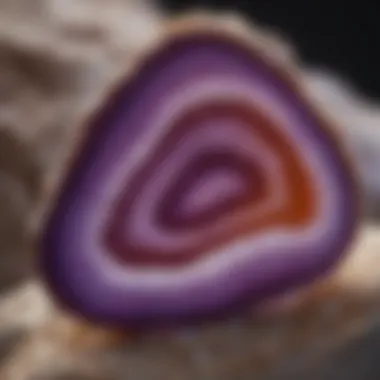
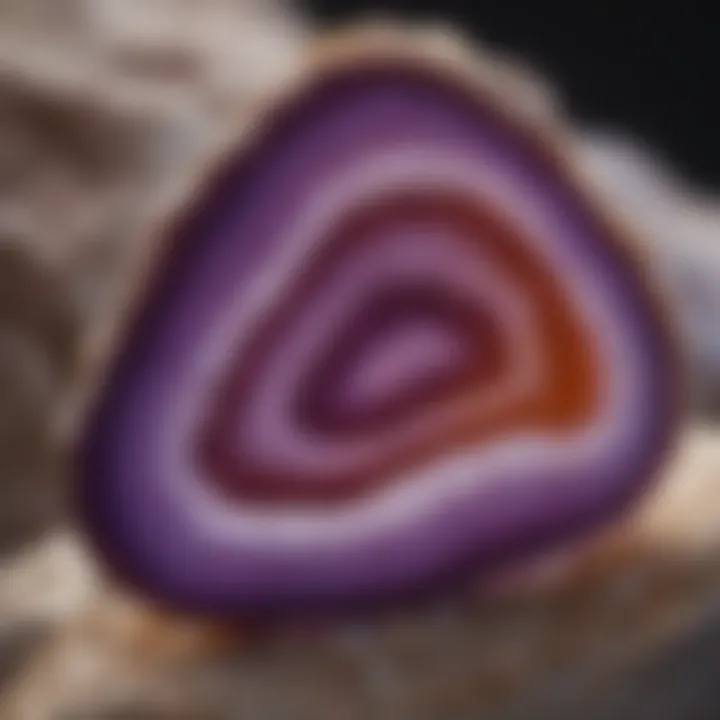
In the Middle Ages, amethyst was considered a stone of sobriety. Clergy often wore it, associating its vibrant color with piety and temperance. This association persisted through the Renaissance, making it popular among the elite.
Notably, in some cultures, purple crystals were used in rituals and ceremonies due to their perceived ability to enhance intuition and spiritual connection.
Symbolism in Different Cultures
The symbolism of purple crystals varies significantly across cultures. In Western societies, purple has long been linked to the concepts of spirituality, ambition, and creativity. It is often seen as a bridge between the physical and spiritual realms.
In Hinduism and Buddhism, purple is often connected to the crown chakra, which is believed to facilitate higher states of consciousness. This connection highlights the spiritual significance these crystals hold, as they are thought to assist in meditation and personal growth.
Furthermore, in some Native American traditions, purple crystals symbolize dreams and intuition. They are used in various healing practices to balance energy and promote clarity of thought.
A significant point is how many cultures also view purple as a representation of wealth and success. The use of these crystals in adornments is not only for beauty but also as a status symbol. Collectors and enthusiasts can find purple crystals in various forms, from raw specimens to intricate jewelry pieces.
"Purple crystals are more than just visually captivating; they embody a rich tapestry of human beliefs and artistic expression."
In summary, the cultural importance of purple crystals is multifaceted. Their historical context, rooted in various traditions, enhances their significance today. Understanding these elements can deepen one's appreciation for these fascinating minerals.
Applications of Purple Crystals
The applications of purple crystals extend far beyond their aesthetic appeal. These minerals hold significance in various domains, encompassing jewelry design, industrial uses, and spiritual practices. Understanding these applications not only aids mineral enthusiasts but also sheds light on the multifaceted nature of these crystals.
Use in Jewelry
Purple crystals, particularly amethyst, are highly sought after in the jewelry market. Their rich hues have made them a favorite among jewelers and collectors. Amethyst is often used in rings, necklaces, and bracelets due to its striking appearance and perceived value. Other crystals like fluorite and sugilite also find their place in unique jewelry designs.
- Aesthetic Appeal: The vibrant colors of purple crystals make them visually appealing. Amethyst ranges from light lavender to deep purple, adjusting to various styles and personal tastes.
- Symbolism: In many cultures, amethyst symbolizes clarity, balance, and peace. Wearing jewelry made from this crystal can enhance one's mood and spiritual well-being.
- Affordability: Compared to some other gemstones, amethyst is relatively affordable, making it an accessible option for those looking to add elegance without high costs.
When acquiring purple crystal jewelry, it is important to verify authenticity. Knowing the origin and treatment of the crystals ensures that buyers receive genuine products.
Industrial Applications
Beyond aesthetics, purple crystals serve important roles in various industrial sectors. The versatility of these minerals is noteworthy. For instance, fluorite is extensively used in the production of aluminum, gasoline, and uranium fuel. Its properties make it a vital component in numerous manufacturing processes.
- Fluorite Usage: Used as a flux in steelmaking. It helps in reducing the melting point of raw materials.
- Ceramics Industry: Fluorite finds applications in producing ceramics and glass due to its high melting point and optical clarity.
- Electronics: Certain purple crystals are used in making electronics due to their insulating properties and thermal stability.
Overall, the industrial relevance of purple crystals highlights their importance not only in decorative contexts but also in practical applications that contribute to technological advancement.
Understanding the applications of purple crystals helps unveil the intricate relationship between mineralogy and human advancement.
Healing Properties and Metaphysical Uses
The healing properties and metaphysical uses of purple crystals hold a significant place in the understanding of these minerals. Many individuals who collect or admire purple crystals often seek to explore their potential benefits beyond mere aesthetics. Here, we dive deeper into the specific elements that highlight these claims.
Holistic Practices
Purple crystals, such as amethyst and fluorite, are frequently associated with holistic healing practices. These crystals are believed to promote emotional balance and stress relief. In many holistic healing circles, purple crystals are used in meditation and energy work to enhance spiritual awareness and foster a sense of peace.
Some common practices include:
- Meditation: Holding or placing purple crystals nearby can help to calm the mind and foster deeper spiritual connection.
- Crystal Healing: Practitioners often lay these stones on specific chakra points to balance energy.
- Grids and Layouts: Arranging crystals in geometric patterns is thought to amplify their healing properties.
Understanding how to incorporate purple crystals into daily routines can enhance their perceived benefits. It is advisable for collectors and enthusiasts to experiment with these practices to discover personal resonance.
Spiritual Beliefs
Spiritual beliefs surrounding purple crystals are rich and varied. Many cultures view these stones as conduits to higher realms and as tools for spiritual growth. Amethyst, in particular, is known for its association with the crown chakra, which is thought to connect individuals to the universe.
Some common spiritual beliefs include:
- Intuition: Purple crystals are believed to sharpen intuition and increase psychic abilities.
- Protection: Many users feel that these stones offer protection against negative energies.
- Transformation: Some see them as catalysts for personal transformation, helping individuals to release old patterns and embrace new beginnings.
"Crystals are not just beautiful objects; they are believed to possess unique energies that can impact our spiritual and emotional health."
By understanding these metaphysical aspects, collectors of purple crystals can deepen their appreciation for these minerals. The intent with which one approaches these crystals may greatly influence their experiences, making this aspect of collecting deeply personal and insightful.
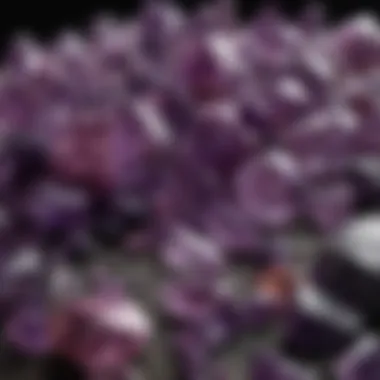
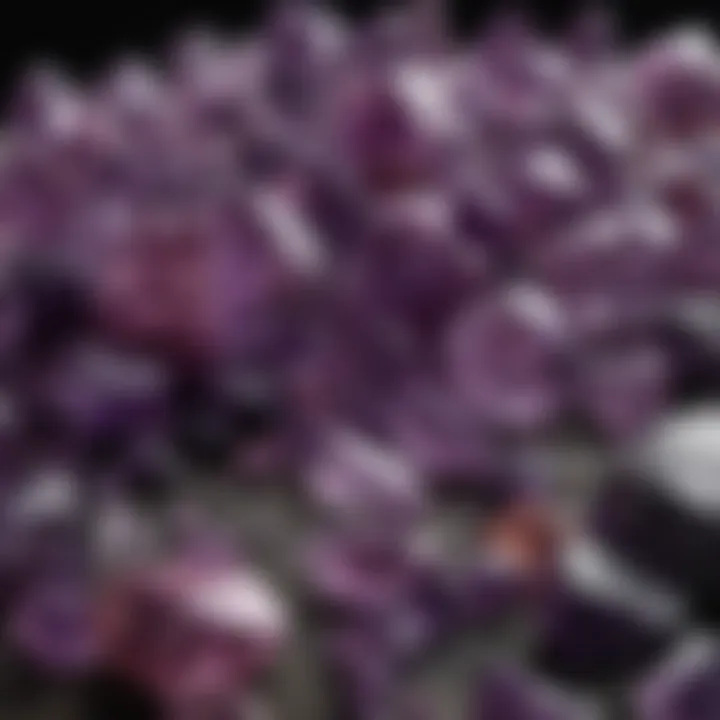
Care and Maintenance of Purple Crystals
Caring for purple crystals is essential to maintain their luster and inherent properties. Proper care and maintenance enhance not only their beauty but also their longevity. For collectors, understanding the nuances of handling these crystals eliminates potential damage and keeps their investment intact.
The significance of this topic lies in the delicate nature of many purple crystals. Whether they are used as jewelry or decorative pieces, exposure to harsh chemicals, extreme temperatures, or improper handling can lead to scratches or discoloration. Therefore, knowing how to care for them is not just beneficial but necessary.
Cleaning Techniques
Cleaning purple crystals requires a gentle approach to avoid any potential damage. Here are some recommended cleaning techniques:
- Water and Mild Soap: A mixture of lukewarm water and mild soap is often sufficient. Dip a soft cloth in the solution and gently wipe the surface of the crystal. Avoid harsh chemicals like bleach or ammonia as they can erode the crystal's surface.
- Ultrasonic Cleaners: For harder crystals like Amethyst, ultrasonic cleaners can work well. However, it is crucial to confirm that the specific crystal type can withstand such cleaning tools to prevent fractures.
- Soft Brushes: For crevices and intricate designs, use a soft-bristled brush. This allows for thorough cleaning without abrasively scratching the surface.
- Avoid Abrasives: Never use abrasive materials which can scratch and dull the shine of the crystal.
Tips:
- Always rinse with clean water after washing to remove any soap residue
- Dry with a soft cloth to prevent water spots
Storage Recommendations
Correct storage is equally important for maintaining the condition of purple crystals. Here are some fundamental recommendations:
- Individual Storage: Store each crystal or piece of jewelry separately. This prevents scratches caused by contact with other crystals or metals.
- Cloth Pouches: Soft cloth pouches work well for individual stones. They protect from dust and scratches, and are easy to store in drawers or boxes.
- Avoid Direct Sunlight: Prolonged exposure to sunlight may fade the color in some types of purple crystals. Consider keeping them in a dark or shaded area when not in use.
- Temperature Control: Store crystals in stable temperature conditions. Extreme heat or cold can cause them to crack or break.
Proper care and maintenance of purple crystals can preserve their beauty and integrity for many years. By following these cleaning techniques and storage recommendations, collectors can ensure that their cherished pieces remain in excellent condition. This diligence heightens enjoyment and appreciation for these intricate and beautiful minerals.
Collecting Purple Crystals
Collecting purple crystals offers not only a hobby but also a deep dive into the realms of geology, aesthetics, and even metaphysical practices. For enthusiasts and collectors alike, understanding the significance of these beautiful minerals can enhance the experience of acquiring them. Being aware of the specific characteristics, rarity, and authenticity of these crystals helps in making informed decisions during collecting.
The process of collecting purple crystals requires a keen eye and knowledge. It’s essential to recognize what makes each type unique. For instance, while amethyst is widely sought after due to its myriad of hues and stunning formations, sugilite is prized for its rarity and vivid color. Each crystal not only carries visual beauty but also embodies geological processes that reflect millions of years of Earth's history. Building a collection based on these attributes can foster a genuine appreciation for mineralogy.
Identifying Authenticity
Identifying authenticity is critical in the world of crystal collecting. The market is filled with imitations and treated stones that can deceive even experienced collectors. Thus, developing skills to discern genuine specimens is beneficial. Here are some pointers:
- Color Variation: Authentic purple crystals like amethyst show color zoning, while fakes often have uniform shades.
- Inclusions: Natural stones frequently contain inclusions, which are parts of minerals or gases trapped during formation. Authentic crystals may display these imperfections.
- Weight Distribution: Real crystals generally feel more substantial compared to synthetic copies. This weight can indicate authenticity.
Investing time to learn about these aspects can significantly increase your success in collecting. A real piece holds more value than a counterfeit one.
"Knowledge is power. Understanding your crystals gives you an edge in collecting."
Valuation and Pricing
The valuation of purple crystals can vary widely based on several factors. Knowledge about these influences will empower collectors when making purchases or assessments. Key elements in determining the worth of a crystal include:
- Rarity: Rare varieties like sugilite command higher prices due to limited availability.
- Size: Larger specimens generally have higher values. However, even small beauties can be highly sought after depending on their quality.
- Quality: Crystals with fewer inclusions and better color saturation tend to be more valuable.
- Market Demand: Trends can affect prices, as certain crystals may be more popular depending on holistic practices.
Understanding these factors helps navigate pricing and aids in building a valuable collection over time. Engaging with collector communities can also provide insight on current market values to make informed decisions.
Epilogue and Future Implications
The study of purple crystals holds significant importance for both enthusiasts and professionals in geology and mineralogy. These crystals, such as Amethyst and Fluorite, are not only beautiful but also rich in history and cultural significance. As this article illustrates, understanding their properties can help collectors make informed decisions and appreciate their value both financially and intellectually.
The future implications surrounding purple crystals extend to several fields including education, science, and holistic practices. The ongoing research about their geological formation processes and the environmental conditions necessary for their growth presents an opportunity to deepen our understanding of Earth’s natural history. Moreover, as society becomes increasingly fascinated with holistic health, the metaphysical uses of these crystals may gain more prominence.
- New collectors and hobbyists can educate themselves about the authenticity and valuation of these crystals.
- Professionals in the gemstone market can explore innovative applications in industries like electronics and jewelry.
- Cultural anthropologists can further investigate how various cultures have assigned meanings to these crystals over time.
Thus, the significance of understanding purple crystals is multifaceted, ranging from enhancing personal knowledge to contributing to broader academic and commercial discussions.
Summary of Key Insights
Throughout this article, various aspects of purple crystals were explored:
- Geological Formation: These crystals have specific formation processes and environmental conditions that influence their appearance and characteristics.
- Cultural Significance: They have been valued not just for their aesthetic appeal but also for their symbolic meanings across different cultures.
- Applications: Purple crystals find uses in both jewelry and various industrial applications, showcasing their versatility.
- Healing Properties: Beyond the physical, their metaphysical applications have gained popularity in modern holistic practices.
Each of these elements plays a crucial role in highlighting the significance of purple crystals in our world.
The Evolving Fascination with Purple Crystals
The interest in purple crystals has evolved notably over the years. Once primarily seen as decorative items, they are now recognized for their complex origins and varied applications. With the rise of the internet, information about purple crystals is more accessible than ever. Online communities, such as those found on platforms like Reddit or Facebook, have fostered discussions among collectors, allowing for the sharing of knowledge and experiences.
Additionally, trends in sustainability and natural wellness are shifting views on these minerals. As people look towards nature for solutions to modern problems, the allure of purple crystals as both aesthetic and practical objects continues to grow. A deeper understanding of their properties and significance can therefore lead to renewed interest and appreciation within both amateur and professional circles.
The future looks promising for purple crystals, with potential advancements in research and technology paving the way for more applications and a greater understanding of their impact on our lives.



